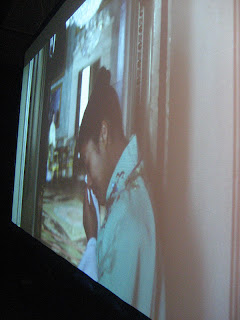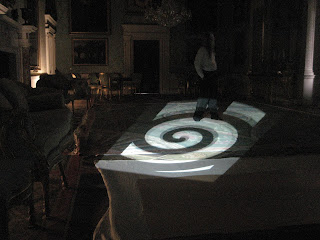© Susan Hiller 2012
" ... Death belongs in our society to the darkness of night, to the repressions of sleep, and dream. Hiller's tape partakes of the language of dream, where the identity of the speaker is inconstant, lost and retrieved... The installation itself with its pale blue and brown tablets and its economy of placements is very beautiful. The connection between the mute, somber images and the elusive, allusive wanderings of the text is fascinating in its provocations: the atmosphere of the piece and the ruminations it engenders stay in one's head for a long while."
Tony Godfrey, Artscribe, 1981
Monument (1980-81) is an installation that inhabits a site, everything within this ‘site’ is defined by the relationships formed between these objects, space, light, distance and sound. Nothing means anything except in relationship. It is not that the park bench and tape recording mean one thing and the photos another. Its that the park bench in relationship to the tape recording, in relationship to the photos, in relationship to the viewer mean something. (Hiller, 2008 p186)
REFERENCE :
Johnstone,.S (2008) Essay by Hiller,.S: Collaborative Meaning: Art as Experience//1982 : The Everyday : Documents of Contemporary Art. London. White chapel Gallery.
What happens if I no longer produce an art object?
Is the object I create a vehicle through which I explore internal manifestations of external observations, OR is it more than that?
Does my art object act as a camouflage, a prop, a crutch or is it a route, a rite of passage, I explore in order to get closer to my truth?
What is it I am trying to say through the object?
If I take away the object what 'language' am I left with?
Something is bothering me about the 'object' and I want to put it down so I can understand the systemic root back to the core where the seed of thought began. To un clutter the vision by releasing layers of material.
In order de-materialize I have to materialize and this is the beginning of my process.
"You have to wrestle the object to the ground in order to make it de-materialize!. Breath life into it before you burn it"
Methodology
1. Think and use the world in which I live, breath, see and experience as a question and answer spring board into enquiry, exploration and definitive process based creation.
"Making Art" Check List :
Explore an idea and translate the mind into matter through the use of signifiers.
Research, question, enquiry, think, make and do.
Consider materials.
Start in order to see, feel and evaluate what is right and wrong aesthetically.
Experiment.
Question : "When placed together do these objects create a narrative, does it work, if not why not?
Communicate.
Collaborate, test ideas and learn so that the final reiteration will be the best it can be.
Reflect.
Evidence.
6 months of development.
Process: Out of the process comes the rational which in turn creates a mirror, which in turn creates a platform from which a conversation can begin...
The objects I choose are already powerfully charged with meaning and my goal is to convey this, MY meaning.
My ultimate challenge which is maybe at Masters Degree level is about -
HOW I convey those meanings.
HOW I convey MY meaning.
HOW I effectively engage my audience, my viewer to "get" my meaning while sifting through their own interpretations until they find mine.
Zen master challenge is to understand myself and then through the process of creative elimination get the viewer, the audience to understand me.
My reading, my statement, my intention.
I have to create a pathway between what I think my idea is and what I want to convey clearly. Stepping beyond the 100 % is making it clear to me and then my viewer.
The objects are charged with meaning and maybe there is a way of manipulating their power, their essential powers and this could be a direction in my practice.
Investigate how other artists create their work. What template, methodology do they use? This approach will not dilute my own practice it will strengthen it.
Being an artist is about finding a language and talking to other artists and people. The problem is being a Contemporary Artist. If we were working in just materials or just processes it would be so much easier.
Objects :
1. Platform Scaffold tower.
2. 6287 Steel Corr.Galv.8/3"x24 Gx10'
3. Redwood Standard 5ths PSE 50x50mm 180008 6 pieces 2/2.3 4/2.00 = 12.60 metre. 17.33kgs.
4. No 2 2x2 wooden frames
4. Water pump
5. Static trapeze artist
Sound:
1. Raindrops hitting a tin roof.
2. Etta James "It's a mans World"
Moving Image:
1. Water
Collaboration:
Exploring the potential for a collaboration. A trio of artistic practice which is intrinsically different but scratch the surface and you find a very strong connecting thread.
How do the differences between the male and female manifest when when they oscillate and collide "in a mans world" where almost anything is possible in sculptural, artistic, material form.
What is it to be a man in a mans world and what is to be female in a mans world?
What is it to be a woman in a mans world and what is it to be male in a mans world?
Is there a meeting place? What does it look, feel and sound like to experience the nature of both within the walls of one body. What happens when these internal walls are being dismantled and how does this manifest externally.
How does the feminine deal with fluctuations and surges in testosterone and estrogen and in the male, vice versa.
David is recording the idea of masculinity through exercise and exploring the similarities between drag queens and American wrestlers.
Lance is exploring his masculinity through the extreme medium of female fashion, the deconstruction of the rainbow flag and a sound recording.
I will be creating a large industrial size sculpture using materials associated with the masculine world of building. The new narrative will explore the simple fact that underneath the male, female divide there is a constantly evolving power struggle between our differences and communication is the key to freedom. The issuing work will create an alliance which will celebrate and expose the queer diversity hidden in a dominant heterosexual hegemony.



















































